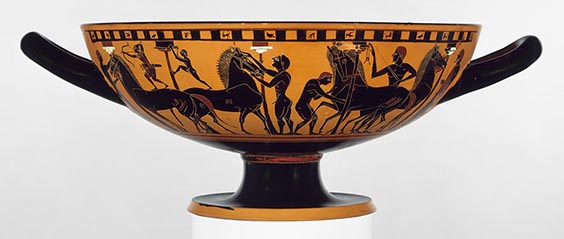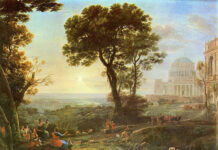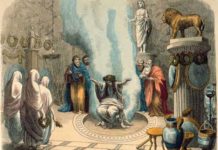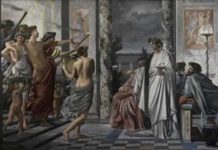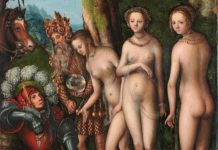The Origins of Greek Art
In the nineteenth century, it was generally believed that Greek art had developed by itself with little or no outside influence. Like almost everything else in Ancient History, this view has been challenged in recent years, and the topic is now hotly debated.
We now know for certain that the Mycenaeans who lived in Greece during the Bronze Age spoke a language that was similar to Greek. This language is probably the one from which the Greek language itself is descended.
It is therefore very likely that ‘Greek’ art, which is usually taken to mean the art of Greece after the eighth century BC, was directly descended from Mycenaean art.
Mycenaean civilisation as a whole was strongly influenced by the earlier Minoan civilisation based in Crete. In fact, in many ways the early Mycenaean civilisation can be considered to have been no more than a provincial version of the Minoan one.
During the Late Bronze Age, trading and cultural links spanned the entire Eastern Mediterranean region.
Minoan style frescoes (some showing the ‘bull-dancers’ for which the Minoans are famed) have been unearthed in excavations in the city of Avaris in the Nile Delta region. Avaris was originally the capital of the Hyksos, who were Syro-Palestinian invaders who conquered northern Egypt early in the second millenium BC.
Even some of the weapons found in the tomb of the Egyptian queen Ahhotep (the mother of the pharoah Ahmose, who founded the New Kingdom) have been described as showing ‘Aegean and Eastern Mediterranean’ motifs.
It may even be possible that Queen Ahhotep was herself a Mycenaean princess who had married the ruler of the Egyptian city of Thebes.
It is only logical then, to imagine that there must have been Egyptian and Near Eastern influences moving in the opposite direction, that is, into the Aegean region.
This is all the more likely because Egypt and the Near East were, at that time, far more advanced than the Aegean cultures, and therfore probably more dominant.
This theory is not accepted by all scholars, many of whom still believe that the Minoan and Mycenaean civilisations had only minimal external cultural influences.
Early Greek Art
The earliest specifically “Greek” (as opposed to Mycenaean) art that we know off comes from the Geometric period, which refers to the ninth and early eighth centuries BC.
This period is so named because the decorations used were generally of geometric patterns.
It is mainly in ceramics that we have artefacts dating from the geometric period. The decorations seen include zigzag patterns, triangles, continuous bands of meanders as well as circular patterns. Representations of horses are also very popular.
Bronze figurines are also found from this period. These figurines are all elongated with broad shoulders.
The next phase of Greek art shows strong influences from Egypt and the Near East. This period is called the Orientalizing Period. It is generally held to be during the eighth and seventh centuries BC.
In vase painting, the advent of animal decorations is characteristic of this period. The most popular animals seem to be lions, bulls, goats and birds. Monsters (sphinxes and griffins) are also frequently shown.
The sculpture of this period shows strong Eastern influences. Many female figurines that are similar to those of Near Eastern goddesses have been found.
It is mainly in the sixth century that what we usually recognise as “Greek” art first came about. This is the beginning of the period known as the Archaic which is followed in the fifth century by the Classical Period.
Sculpture
The sculpture of the Archaic Period still shows some Eastern, specifically Egyptian, influence. Marble sphinxes and lions are still to be found in a lot of instances.
The figures in early Archaic sculpture were still stiff and formal, as were the Egyptian statues from which their essential forms are derived.
It is with the beginning of the Classical Period that Greek Sculpture really came into its own.
The most famous sculptor of the Classical Period was Pheidias, who was a friend of Pericles. He was not only responsible for the great gold and ivory statue of Athena that stood in the Parthenon, but also crafted the statue of Zeus in Olympia, which was once described as ‘adding something to religion’.
A cup belonging to Pheidias was actually discovered during the excavations in Olympia in the 1950s.
The advances in sculpture during the classical Period were nothing short of revolutionary.
The stiff-limbed figures of the Archaic period were replaced by statues that show tremendous fluidity of movement. The representation of clinging folds of garment was another advance in the sculpture of this period.
In short, for the first time ever, realistic representation came to Greek art.
Although Egyptian statuary from the Middle and New kIngdom period also showed quite realistic representations of the human form, these had always been in stiff, formal and essentially static poses. Little motion had been expressed in Egyptian statuary (although of course it had been in tomb paintings)
On the other hand, Greek statues from the classical period show figures in all manners of dramatic poses, including flying through the air!
In this way, the Greeks of the Classical period had really made a revolutionary contribution to the art of the ancient world.
Architecture
The image of Greek architecture that springs most readily to the minds of most people is probably the Parthenon.
Of all the images of Classical Athens that have been romanticised, it is probably that of the Parthenon that has been subject to the greatest distortion.
The conventional image of the Parthenon is one of gleaming white marble columns, as befits the romantic image of a ‘temple of light and purity’ that has been popularised.
The reality was somewhat different.
We now know that the whole building including the sculptures and the friezes were all garishly painted in bright colours. The overall effect would probably have been a lot closer to that of the temples of India or China, than to the standard idea that we now have about ‘classical’ architecture.
Unlike sculpture, the form of Greek temple architecture did not change substantially during the classical period.
(In the ancient world, it was mainly monumental architecture that mattered)
The same basic layout was preserved throughout the fifth century BC.
Vase Painting
During the Archaic period, black figure vases became popular.
Black figure vases were made by painting on the decorative detail onto a ceramic vase with black paint. This produced a striking representation that had a bright red background and a dark figure painted on it.
Details could then be added on to the figure by incising the black area.
In the late sixth century (that is, just before the beginning of the Classical Period) the new red figure technique came into vogue.
In this technique, it was the red of the clay itself that made up the figure, and the background was made up of black paint.
This allowed more and better detail to be added as the details were now painted on instead of just being incised on the previously painted area.
With the introduction of the red figure technique, the market for vases all over the Greek world was cornered by the Athenians. Athenian vases were exported to Southern Italy and Sicily.
Vase painting is a great source for the social history of Athens, as we can see many scenes from dily life painted on these vases.
Much of what we know about the symposia for example comes from scenes of symposia that have been painted on to these vases.


